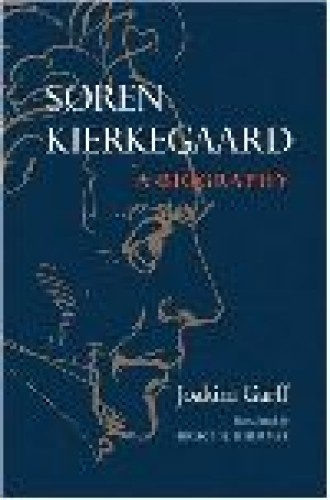Søren Kierkegaard
Joakim Garff’s justly acclaimed biography of Kierkegaard, published in English in the year marking the 200th anniversary of the birth of Hans Christian Andersen, invites us into the literary world of Denmark’s golden age. It also calls us to ponder Kierkegaard in the context of his ambitious, anxiety-ridden life and through the eyes of his contemporaries.
The text is masterfully translated by Connecticut College historian Bruce H. Kirmmse, whose collection of eyewitness recollections of Kierkegaard, Encounters with Kierkegaard, appeared in 1996. Though Garff demands much of his readers, his lively, conversational prose draws us into Kierkegaard’s mind and cultural setting.
This is the story of a remarkable Christian who suffered intensely in his inwardness. Like Socrates, Kierkegaard was determined to render our life choices, including those about religious faith, more difficult. Garff’s interrogation of this unusual life reminds us not just of Kierkegaard’s mental anguish, but also that his dazzling brilliance as a writer burdened both his own existence and that of his contemporaries.
Garff has long pored over Kierkegaard’s journals and notebooks, as well as his published works, and he has concluded that the pseudonymity Kierkegaard held to in his main works allowed him to be more frank and direct about his beliefs, while the private journals and papers written under his own name are more guarded. Garff thereby sets aside what scholars call the problem of pseudonymity: “which of the masks really speaks for Kierkegaard?” Garff’s solution seems plausible.
Garff has also creatively resolved the problem of putting Kierkegaard’s material in order. Outwardly the book develops chronologically. It is divided into five sections that cover the periods of Kierkegaard’s youth and education, the main writings of the 1840s, his literary row with the Corsair, Kierkegaard’s increased disillusionment, and finally his attack on the church, his sense of martyrdom and his death. Within that frame, the philosopher’s career unfolds.
But the presentation isn’t entirely chronological. Because Garff begins the book with an account of the death scene, readers know of the befuddlement that surrounds Kierkegaard’s end and must then wonder how it came to be. Flashbacks and anticipations in the form of vignettes and brief descriptions of specific episodes fill the story with suspense.
The biography brings early-19th-century Copenhagen alive street by street, depicting clothing styles, sanitation problems, disease and harlotry alongside the city’s high literary and philosophical culture.
Familiar figures are presented, along with fresh insight into how they figured into the writer’s pursuits: Kierkegaard’s jilted fiancée, with whom he retains a kind of relationship; his obsessively religious, adulterous father, who haunts him at every point; his estranged older brother, who suffers from dementia; the much admired Poul Martin Møller, whose early death robs Kierkegaard of a literary ally; a local literary giant who fails to recognize Kierkegaard’s genius; his nemesis in the Corsair affair, who moves to Paris to get away; his former teacher H. L. Martensen, who is skeptical of Kierkegaard’s character and becomes the bishop of Seeland; and, finally, the bishop and churchman J. P. Mynster, who epitomizes for Kierkegaard the reasons why the Christianity of the New Testament no longer exists. In Garff’s deft hands we see these characters’ complexity. We also see that the polemical treatment Kierkegaard gave them was often undeserved, or only partly deserved.
From beginning to end Garff writes with immense feeling for the internal conflicts and ambitions that inform Kierkegaard’s authorship. Though he tried, Kierkegaard could never walk away from his troubles. His sociability and daily perambulations among the Copenhagen characters he loved served him well, at least until his ruin at the hands of the Corsair. Apart from trips to the countryside and four journeys to Berlin, Kierkegaard’s travels were internal; they took place inside his own mind and were duly recorded in journals, notebooks and papers. Garff confirms both that Kierkegaard was a writer of uncommon sensitivities and that he was often a difficult person; indeed, his temperament may have played a role when his gifts went unrecognized by the only literary circle that appears to have mattered to him.
Garff does not explore head-on Kierkegaard’s arguments about existence, God and moral obligation, which are of interest to philosophers, theologians and ethicists. Philosophical Fragments, Concluding Unscientific Postscript, Works of Love and Sickness unto Death receive sporadic and limited notice compared to works that disclose Kierkegaard’s inner life, his character and his aims as a writer. This approach perfectly fits Garff’s aims, challenging those concerned with Kierkegaard’s theological and philosophical views to think about the life that produced the teachings.
But the theological Kierkegaard studied in divinity school is only apparently absent from these pages. Though it is unstated, a theological lesson pulses through the book: Kierkegaard’s tormented Christian soul was living out the very pride, ambition, anxiety, sin and hope for redemption that his works so stunningly illuminate. An Augustinian or Niebuhrian reader might well finish the book with a sigh and say, “Well, yes, I guess I will take my treasures in earthen vessels, especially if they are crafted in golden-age Denmark.”
Those who find so large a book daunting may wish to sneak up on Garff’s Kierkegaard by first taking some soundings on their own. This could include dipping into Kierkegaard’s journals, marvelously displayed in Alastair Hannay’s one-volume Papers and Journals: A Selection (1996); rethinking what can be theologically appropriated from Kierkegaard with the help of David J. Gouwens’s Kierkegaard as Religious Thinker (1996); or experiencing a personal encounter with Kierkegaard’s ethics by picking up Gordon Marino’s Kierkegaard in the Present Age (2001). Hannay’s Kierkegaard: A Biography (2001) also enriches the world of Kierkegaardiana.





